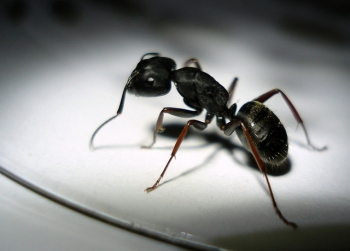The Basics of Carpenter Ants

You should consider yourself quite lucky if you have not yet met a carpenter ant. Carpenter ants are large in size and in some states they are the largest ants around. Additionally, there are a number of different species that could infest your home. In most cases, they are 3/8 to a half inch in length. The winged queens can be as big as a full inch in length. In most cases, you will find black carpenter ants, but some can be red or even yellowish.
Tunneling Menaces
Carpenter ants can live inside or outside, but in every case, they love moist wood that is decaying or even already hollowed out. Once inside, they build a network of tunnels, sometimes called galleries, so they can move from section to section of the nest. You may actually notice what looks like sawdust near those tunnels, as that’s what they leave behind. In many cases, some will leave to set up a satellite colony, helping to further infest your property.
Searching for Food
Many believe that carpenter ants live on wood itself, but that’s just not the case. They live inside the wood, but they do require other food sources. They’ll eat almost anything people eat, but they really love sweet items and meats. When they’re not in a home, they consume insects, both alive and dead. Once inside your home, they look for syrup, honey, sugar, jelly, grease and fat. Keeping your house as clean as possible can help to eliminate them, but it’s certainly not a guarantee.
Symptoms of an Ant Problem
When most people first notice carpenter ants, they often have trouble deciding whether they have an ant problem or a termite problem. Carpenter ants, though, look a bit different. They’re willing to go out into the open, while termites usually aren’t. They don’t like the light. Carpenter ants also have much darker colored bodies. Termites are usually lightly colored. Carpenter ants often have fairly narrow waists and antennae that are bent. Termites, on the other hand, not have a constriction at the waist, and their antennae are straight.
If you do have a carpenter ant infestation, you’ll likely notice a trail of works near your food storage areas. You may also see the sawdust like material that the workers leave behind as they’re excavating tunnels. Additionally, it’s possible that you might hear ant sounds when things are very quiet. The chewing and moving around sounds like rustling paper.
Carpenter Ant Treatment
Prevention is the best possible method of treatment. One great way to keep an infestation away from your property is to make certain high moisture conditions don’t have a chance to develop. Replace any wood that has become damaged by moisture, and make certain all of your lumber is stored outside of the house. Firewood should be stored well away from any buildings, and rotting trees and other vegetation should be removed immediately.
If you suspect you have a problem with carpenter ants, make certain you locate and destroy the nest. Simply spraying the ants won’t solve the problem. Your best bet is to contact a professional pest company to ensure complete elimination.
